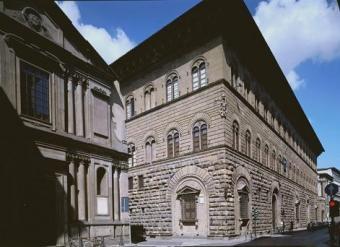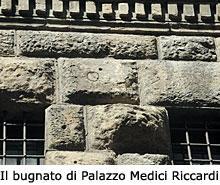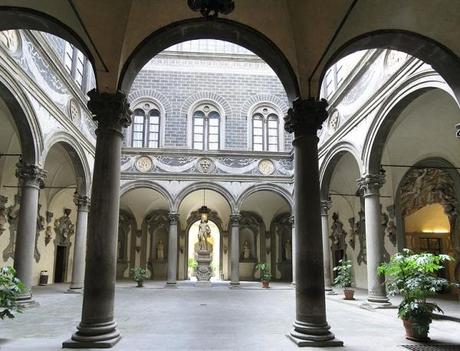
Palazzo medici
One of the art city par excellence is Florence. Its monuments, its streets, all in this city is the testimony of a magnificent past. What we can appreciate today are the legacies of the past-valuable evidences to better understand what we are now. The beautiful Florence was ruled by the Medici family, who left some important artistic evidences. During the splendor of the fifteenth century some monuments and palace of great architectural importance were built. One in particular, Palazzo Medici. The architect was the famous Michelozzo, official architect of the Medici family. He understood the architectural innovations brought by Brunelleschi (there are many examples of this architect Florence)and he had interpreted them freely in his palaces.

the courtyard
This palace is in Via Larga and it had some changes during the centuries. Very characteristic is the rusticated that we call BUGNATO which originates from the Florentine artistic tradition (stones that emerge from the building, usually on the underside). Usually this technique was applied to the public buildings, but Michellozzo interpreted it for the Medici family . All inside, the building is organized around the courtyard, narrow as in the classic medieval style. There is also a second courtyard which adjoins the road behind and it seems to create a transition from the public to private. This concept was very important because it underlined, once again, the intention to be open and transparent: the palace can be seen from outside the city and it opens to the society in which it is inserted. You will have a very overwhelming visit in Florence with all the palaces and the monuments: you will feel wrapped in a glorious past and in a pleasant environment. Arm yourself with a camera, a good guidebook and a great desire to discover . Florence enchant me every time, this is why I love this city deeply.Some other ideas for visiting Florence http://www.learnitalianow.net/2012/04/what-to-visit-ponte-vecchio-florence.html
http://www.learnitalianow.net/2012/10/santa-maria-del-fiore-and-brunelleschis.html
http://www.learnitalianow.net/2012/01/what-to-visit-galleria-degli-uffizi.html
http://www.learnitalianow.net/2012/02/what-to-visit-piazza-della-signoria.html
Una delle città d’arte per eccellenza è Firenze. I suoi monumenti, le sue strade il suo insieme sono la testimonianza di un passato magnifico. Quello che possiamo apprezzare noi oggi sono i lasciti del passato, preziose testimonianze che ci permettono di capirci meglio. La bella Firenze fu sede della famiglia de Medici che lasciò un’impronta artistica di grande importanza. Lo splendore del XV secolo fece sì che sorgessero monumenti e palazzi di grande rilievo architettonico. Uno in particolare: Palazzo Medici. Il costruttore fu il famoso Michelozzo, architetto ufficiale della famiglia Medici. Egli comprese le novità architettoniche che Brunelleschi ( di cui tanti esempi potrete trovare sempre a Firenze) aveva apportato e le interpretò liberamente nelle sue costruzioni. Ci sono delle scelte molto particolari che spesso raccontano uno specifico modo di rapportarsi: determinati gesti e dimostrazioni sono importanti da parte di chi regna verso il popolo. Ogni tanto basta guardare indietro nella storia e seguirne gli esempi. Un caso? Prendete la famiglia Medici a Firenze, fu un emblema di democrazia e rispetto anche nelle scelte personali. Quando decisero di farsi costruire un loro palazzo, che oggi potete riconoscere come palazzo Medici, evitarono ogni forma di ostentazione onde evitare di dare un’immagine negativa del loro potere. Era indiscutibile che fossero potenti, ma un conto è esserlo e non essere ben voluti, un conto è essere apprezzati. Il palazzo fu costruito intorno al 1444. Pare che inizialmente Cosimo de Medici avesse affidato il progetto allo stesso Brunelleschi , ma essendo troppo principesco era stato rifiutato e dato a Michelozzo. La famiglia Medici voleva qualche cosa di decisamente più sobrio per non offendere il popolo : non volevano ostentare ricchezze, ma volevano dare l’impressione di essere persone di fiducia che governavano Firenze. Si potrebbe dire una posizione molto democratica e intelligente da cui si potrebbe prendere esempio! Il palazzo si trova in Via Larga e subì cambiamenti nel corso dei secoli . Molto caratteristico è il rivestimento a bugnato che trae origine dalla tradizione artistica fiorentina ( pietre più o meni sporgenti che fuoriescono dal palazzo, solitamente nella parte inferiore).Di solito questa tecnica era applicata ai palazzi pubblici, ma Michellozzo la reinterpretò per la famiglia Medici . All’interno il palazzo si organizza intorno al cortile, stretto come nel classico stile medievale, esiste anche un secondo cortile che confina con la strada retrostante e sembra creare un passaggio tra il pubblico al privato. Questo concetto era molto importante perché sottolineava, ancora una volta, l’intenzione di essere aperti e trasparenti: il palazzo può essere visto dal cittadino esterno e si apre alla società in cui è inserito. Tra palazzi e monumenti la visita a Firenze sarà intensa: ci si sente avvolti in un passato glorioso e in un ambiente piacevole. Armatevi di macchina fotografica, una buona guida e tanta voglia di scoprire: Firenze lascia incantati ogni volta, per questo io la amo profondamente.

